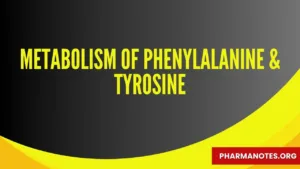Metabolism of Phenylalanine & Tyrosine

Objective
• At the end of this lecture, students will be able to
– Explain the metabolism of phenylalanine & tyrosine and their metabolic disorders
Metabolism of phenylalanine & tyrosine
• Phenylalanine and tyrosine are structurally related aromatic amino acids
• Phenylalanine is an essential amino acid while tyrosine is non-essential
• Besides its incorporation into proteins, the only function of phenyl alanine is its conversion to tyrosine
• For this reason, ingestion of tyrosine can reduce the dietary requirement of phenylalanine
• This phenomenon is referred to as ‘sparing action’ of tyrosine on phenylalanine
Biosynthesis (conversion of Phenylalanine and Tyrosine)
• Degradation of phenylalanine mostly occurs through tyrosine
• Phenylalanine is hydroxylated at para-position by phenylalanine hydroxylase to produce tyrosine(p-hydroxyphenylalanine)
• This is an irreversible reaction and require phenylalanine hydroxylase and specific coenzyme biopterin, which is structurally related to folate
• The active form of biopterin is tetrahydrobiopterin
• In the phenylalanine hydroxylase reaction, tetrahydrobiopterin is oxidized to dihydrobiopterin
• Tetrahydrobiopterin is regenerated by NADPH-dependent dihydrobiopterin reductase
• The enzyme phenylalanine hydroxylase (liver) convert phenylalanine to tyrosine, the reaction involves the incorporation of one atom of molecular oxygen (O2) into the para position of phenylalanine while the other atom of O2 is reduced to form water
• Tetrahydrobiopterin that supplies the reducing equivalents which, in turn, are provided by NADPH
• Defect in phenylalanine hydroxylase leads to phenylketonuria (PKU)
DISORDERS OF TYROSINE (PHENYLALANINE) METABOLISM
• Phenylketonuria: Defective phenylalanine hydroxylase
• Tyrosinemia type II: Defective Tyrosine transaminase
• Neonatal tyrosinemia: Defective p-hydroxyphenyl pyruvate dioxygenase (Tyrosinemia type III)
• Alkaptonuria: defective homogentisate oxidase
• Tyrosinemia type I: Defective fumarylacetoacetate hydroxylase and/or maleyl acetoacetate isomerase
• Albinism: Defective tyrosinase
Metabolic disorders
Phenylketonuria (PKU)
• Deficiency of phenylalanine hydroxylase – classical
• New variant – due to deficiency of dihydrobiopterin reductase
• Mental retardation
• Effect on pigmentation
• Treatment- Dietary approach
Tyrosinemia type II:
• Very rare
• Herpetiformic keratitis
• Palmoplanter hyperkeratosis with ulcers
• PMR, growth retardation
• Dietary treatment
• Richner-Hanhart syndrome
• Defective enzyme: tyrosine transaminase
• Accumulation of tyrosine and its metabolites
• Skin (dermatitis) and eye lesions
• Mental retardation
Neonatal Tyrosinemia
• Absence of p-hydroxyl phenyl pyruvate dioxygenase
• Well responded to ascorbic acid therapy
Tyrosinemia type 1
• Deficiency of fumarylacetoacetyl hydroxylase and/or maleylacetoacetyl isomerase
• Causes:
• Liver failure
• Poly neuropathy
• Rickets
• Renal tubular dysfunction
Alkaptonuria
• Deficiency of Homogentisate oxidase
Albinism
• Lack of synthesis of pigment melanin
• Defect in tyrosinase-enzyme responsible for synthesis of melanin
• Deficiency or lack of the enzyme tyrosinase.
• Decrease in melanosomes of melanocytes.
• Impairment in melanin polymerization.
• Lack of protein matrix in melanosomes.
• Limitation of substrate (tyrosine) availability.
• Presence of inhibitors of tyrosinase.
Diagnosis and Treatment
Early diagnosis of phenylalanine and tyrosine metabolic disorders is crucial for effective management.
Screening methods such as newborn screening allow for the early detection of these disorders, enabling timely intervention through dietary modifications and supplementation with cofactors like BH4.
Summary
• Children with Alkaptonuria are asymptomatic, besides producing brown or black urine
• Treatment for classic PKU is a strict PHE-restricted diet supplemented by a medical formula containing amino acids and other nutrients
Unique FAQs:
- What are the symptoms of phenylketonuria (PKU)?
- Symptoms of PKU include intellectual disability, seizures, behavioral problems, and a musty odor in the breath and urine.
- Can phenylketonuria (PKU) be cured?
- There is no cure for PKU, but early diagnosis and dietary management can prevent symptoms and complications.
- What foods should individuals with PKU avoid?
- Individuals with PKU should avoid high-protein foods containing phenylalanine, such as meat, fish, eggs, dairy, and certain grains.
- Is tyrosinemia a treatable condition?
- Tyrosinemia can be managed through dietary restrictions and medication, but severe cases may require liver transplantation.
- Are there any alternative treatments for phenylketonuria (PKU)?
- Emerging therapies such as enzyme replacement and gene therapy are being investigated as potential alternative treatments for PKU.
Also, Visit:
B. Pharma Notes | B. Pharma Notes | Study material Bachelor of Pharmacy pdf







